Feathered friends
Sitting quietly outdoors in a favourite sunny spot is made extra special when wildlife comes visiting. During winter, birds’ usual supply of food from trees can be in short supply, so supplementary feeding is a great way to encourage them to stay around.
As s temperatures start to plummet native birds need all the extra energy they can store to prepare themselves for the coming cold. Energy in the form of fats and proteins is ideal, and nectar seeking birds will flock to a sweet drink.
To make a sweet drink for nectar feeding birds such as Tui. Dissolve half a cup of sugar in four cups of water. Tui and bellbirds will love this when their usual nectar trees are not in flower. Avoid feeding honey. While the birds love this, so do bees and there is a risk of spreading disease. The best feeder for sugar solution is a frame which supports an upside down bottle with its opening immersed in a bowl.
Many birds love fruit. A cut apple or orange offered on a stake doubles as a perch for smaller birds. Other fruit loved by birds are persimmon, figs, feijoa, plums and pears. Seed attracts many wild birds, especially introduced species such as thrush and sparrows.
Hang feeders in tree branches or attach them to a high fence where birds will feel safe to visit. Keep feeders topped up through winter so birds can rely on their favourite café being open all hours.
Many birds are attracted to feeding tables offering fruit, seeds or fatty treats. They will eat dry rolled oats and porridge but cooked oats can cause problems as it can harden around birds beaks. Avoid bread, which usually contains salt, and potentially other harmful ingredients that are not a healthy option for any bird. It is far better to buy seed products that are specifically blended for wild birds.
Water
Birds love a bath. There is good evidence to suggest they need regular bathing to keep their wings in good flying condition and that bathing helps remove harmful parasites from feathers. A birdbath in the garden doubles as attractive garden art and a practical enticement for birds, offering them a place to drink, wash or have a cooling swim in summertime.
Birdbaths don’t have to be expensive. One easy-to-make option is a trio of terracotta pots in graded sizes stacked upside down with a large terracotta saucer glued on
top. A stack of bricks also makes a simple bird bath base. Alternatively, a hanging birdbath can be made using a terracotta saucer supported with rope. Search the internet for clever ideas. A well-designed bird bath is shallow with plenty of space for birds to perch on its rim. Place pebbles or rocks in the base of deeper birdbaths.
If you want to enjoy birds splashing about in your birdbath on a regular basis it is important to keep it clean and topped up with fresh water every day or two. Most birds need to drink water every day. When you go away, ask a neighbour or house sitter to keep the birdbath topped up so your local birds know they can depend on it. In winter, replacing icy water with warm water can prove to be extra enticement for feathered friends.
Ideally a birdbath should have some shade, especially on hot summer days. This helps slow down the evaporation of water and keeps the water fresher for longer. Situate your bird bath so that it is out of easy reach for cats and where there are trees or shrubs nearby for an easy escape route for the birds. If they have somewhere to perch where they can watch and wait while they prepare for their swim and which is within easy flying distance when feathers are wet, they might choose your birdbath over one that doesn’t feel so safe. Even better if an overhanging tree has a source of food.
Many birds are attracted to moving water. A small fountain may well increase the variety of birds paying a visit to your garden.
Keeping birds safe
- Keep cats inside, especially at night.
- Set traps to control introduced predators like rats, stoats, and possums.
- Keep feeding stations well out of reach of predators.
- Clean feeders and bird baths to avoid the spread of disease.
- Provide drinking water for birds, especially in summer.
Wildlife and winter colour
Even a small town garden can be planted to attract a wide range of birds. During the lean season, some of our most colourful winter flowering trees and shrubs provide a banquet of food for nectar seeking birds.
It’s no coincidence that the shape of our national flower closely matches the beak of a tui. Kowhai trees herald the arrival of spring with a riot of golden flowers in gardens and on forest margins and riverbanks from North Cape to Bluff. Depending on your climate, and which variety you plant, kowhai trees start blooming as early as July. Kowhai are easy to grow in sun or part shade and any well-drained soil. There are varieties to suit a wide range of climates and landscape situations. Being legumes, kowhai trees can fix their own nitrogen and can tolerate quite poor soils, but they do need plenty of moisture. Close cousin, the beautiful spring flowering ngutukākā (aka kakabeak) is named for the shape of its striking red flowers. This beautiful shrub is endangered in the wild.
Banksia flowers are living proof that nectar seeking birds make no distinction between native and introduced plants when prized food is on offer. Tui and bellbirds especially love Australia’s banksias, which flower mainly in winter and are laden with sweet nectar. Banksias also attract insects, a further food source for birds. The strikingly architectural flowers are produced in huge profusion for many weeks and make beautiful vase flowers too. Taller banksias make excellent shelter trees. Dwarf forms, such as ‘Birthday Candles’ produce a fabulous show of flowers on low spreading shrubs.
Also native to Australia, the prolific flowering Grevillea cultivars attract a wide variety of birds while bringing vibrant colour to the winter garden. Their spider-like flowers will cover an entire shrub in bright shades of red, orange and gold or softer shades of lemon and cream. Grevilleas range from ground carpets to tall trees, with many garden-friendly sized shrubs in between.
The Australian bottlebrushes, aka Callistemon, are tough flowering shrubs or small trees that forgive less than perfect soils and tolerate dry windy conditions. Great for coastal gardens they flower at times when our pohutukawa are not. There are many bottlebrush varieties, mainly in shades of red and pink, and a choice of growth habits including the reliable dwarf form ‘Little John’.
Trees and shrubs with colourful berries offer colour for garden and vase while providing a nutritious food source for birds. Well-known exotics with berries include Ilex, (holly) Viburnum, Cotoneaster and Pyracantha. Unfortunately, some species of these plants have turned out to be so successfully distributed by birds that they’ve become weedy and are no longer sold in garden centres. More information on weedy species can be found on www.weedbusters. co.nz. Native Corokia shrubs have fine grey-green foliage that contrasts beautifully next to larger greener leaves. Left untrimmed, corokias will produce red, orange or yellow berries which attract birds. If you have room to plant a ‘wild’ corner of the garden, try the green native species of coprosma for their rapid growth and mass of orange berries loved by birds. In larger gardens the puriri tree is well worth planting for the birds as, with both nectar-filled flowers and sought-after fruit, it provides birds with food for many months.
Fruit trees provide food for both humans and birds. Sometimes there is enough for all of us and sometimes birds are pests necessitating the use of nets. In late autumn a persimmon tree becomes a blaze of colourful leaves and fruit, with hundreds of hungry visitors adding to the vibrant scene. Silver eyes are very partial to persimmon. Other garden fruits the birds will enjoy are figs, feijoas, crabapples and rose hips.
Planting for birds
|
|
| Shrubs | Shrubs |
| Aloe | Coprosma |
| Banksia | Corokia |
| Callistemon (bottlebrush) | Cotoneaster |
| Grevillea | Phormium (flax) |
| Phormium (flax) | Pseudopanax |
| Protea | |
| Small Trees | |
| Small trees | Ficus (fig) |
| Banksia | Feijoa |
| Sophora (kowhai) | Guava |
| Prunus (flowering cherry) | Persimmon |
| Pittosporum | |
| Large trees | Prunus (crabapple) |
| Eucalyptus (flowering gum) | Rhopalostylis (nikau) |
| Grevillea (silky oak) | |
| Metrosideros (rata, pohutukawa) | Large trees |
| Vitex (puriri) | Melia |
| Karaka |

5-Jun-2019
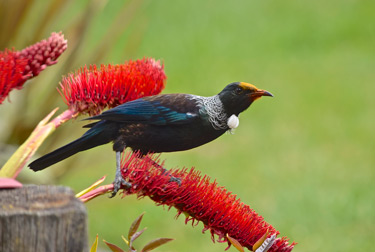
Tui, covered in pollen, on Xeronema (Poor Knight's Lily)
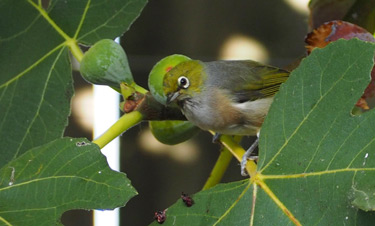
Silvereye on fig
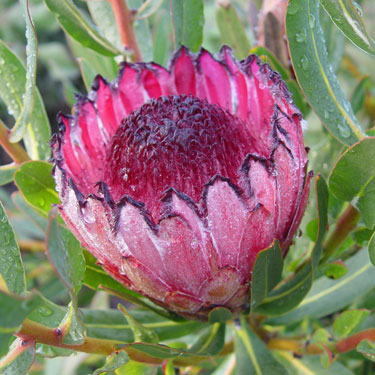
Protea
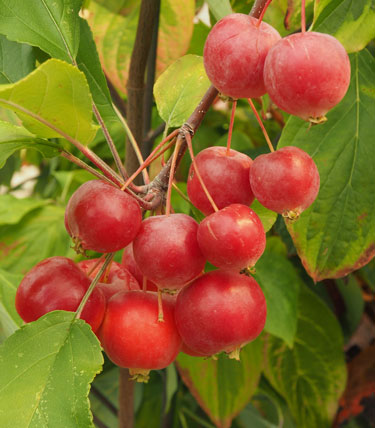
Malus - crabapple
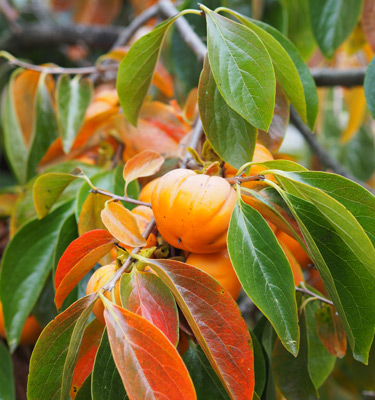
Persimmon
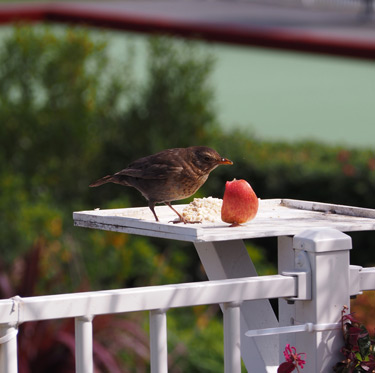
A safe and secure feeding table
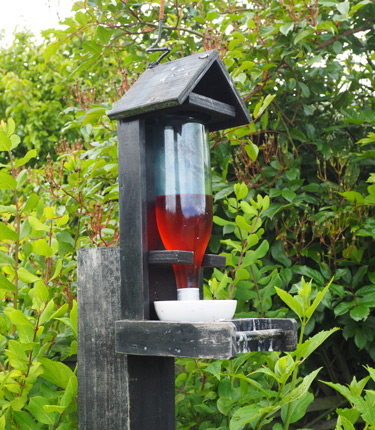
Bird feeder for birds

